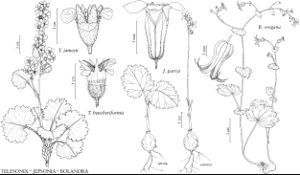Jepsonia
Bull. Torrey Bot. Club 23: 18, plate 256. 1896 ,.
Herbs, (acaulescent, heterostylous), not rhizomatous, not stoloniferous; caudex branched or unbranched, ovoid or flat, cormlike, fleshy, without scales. Flowering-stems (usually appearing in autumn or winter after basal leaves have withered), erect or ascending, leafless, 3–28 cm, stipitate-glandular, slightly viscid. Leaves in basal rosette and cauline; stipules present; petiole stipitate-glandular; blade ovate to suborbiculate or orbiculate-reniform, shallowly lobed, base cordate, ultimate margins crenate with callous-apiculate teeth, apex obtuse to rounded, surfaces hairy; venation palmate. Inflorescences cymose-panicles, (origin of inflorescences not readily resolvable), 2–17-flowered, sometimes flowers solitary, bracteate, (simple or branched distally, glandular-viscid or glabrate). Flowers heterostylous; hypanthium free from ovary except at base, yellow-green to pinkish; sepals 5, yellow-green to pinkish; petals 5, white, veins prominently colored, (spatulate to elliptic, glabrous); nectary tissue not visible; stamens 10; filaments subulate, (alternate ones surpassing sepals); ovary superior, 2-locular, carpels connate to middle; placentation axile (appearing marginal); styles 2; stigmas 2. Capsules folliclelike, 2-beaked. Seeds brownish, irregular in outline with pinched, curved base, reticulate with longitudinal wings or ridges. x = 7.
Distribution
Calif., nw Mexico
Discussion
Species 3 (3 in the flora).
Jepsonia is characterized by heterostylous flowers that are produced in the autumn after summer drought; some flowers have long styles and short stamens; others have short styles and long stamens. The floral differences associated with heterostyly within populations in this genus are part of an incompatibility mechanism that prevents self-fertilization. Leaves appear after flowering and persist through the winter if moisture is available. Rarely, leaves and flowers are present simultaneously. All three species of Jepsonia also produce a secondary taproot each year. This structure begins to grow after seasonal rains and shrivels before flowering begins. It apparently acts as a contractile root. The three species in this genus are narrow allopatric endemics.
Selected References
None.
Lower Taxa
Key
| 1 | Caudices unbranched, ovoid to spheric; leaves 1(-3); inflorescences 1-5(-10)-flowered; hypanthia 2+ times sepals; sw California, n Baja California. | Jepsonia parryi |
| 1 | Caudices branched, ovoid or flat; leaves 2-3; inflorescences (3-)4-17(-25)-flowered; hypanthia ± equaling or to 1.5 times sepals; Sierra Nevada foothills or Channel Islands | > 2 |
| 2 | Peduncles pink or reddish, branched near middle; petals withering; pollen bluish or cream; seeds light brown. | Jepsonia heterandra |
| 2 | Peduncles greenish or olive, branched distally; petals persistent; pollen yellowish; seeds dark brown. | Jepsonia malvifolia |
"full" is not a number.
